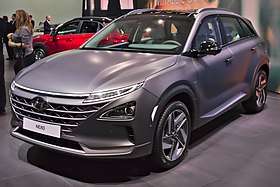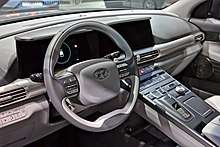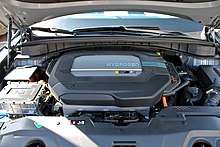Hyundai Nexo
| Hyundai Nexo | |
|---|---|
 | |
| Overview | |
| Type | fuel cell SUV |
| Manufacturer | Hyundai Motor Company |
| Production | 2018-present |
| Model years | 2019–present |
| Body and chassis | |
| Body style | SUV |
| Doors | 5 |
| Powertrain | |
| Electric motor | 120 kW (163.2 PS) / 395 N⋅m (291.3 lb⋅ft) |
| Range |
|
| Dimensions | |
| Wheelbase | 2,790 mm (109.8 in) |
| Length | 4,670 mm (183.9 in) |
| Width | 1,860 mm (73.2 in) |
| Height | 1,630 mm (64.2 in) |
| Curb weight | 1,227–1,328 kg (2,705–2,928 lb) |
| Chronology | |
| Predecessor | Hyundai Tucson/ix35 FCV |
The Hyundai Nexo is a hydrogen fuel cell powered crossover SUV[1] that was revealed at the 2018 Consumer Electronics Show on January 8, 2018.[2] Set to replace the Hyundai Tucson FCEV, the Nexo will be the flagship for Hyundai's eco car portfolio. Hyundai plans to introduce up to 18 eco cars in the global markets by 2025, and sources are told that India also happens to be a key area of focus.
Unlike the Tucson FCEV that used a heavily modified version of the Tucson's underpinnings, the Nexo uses a purpose-built platform from an FCEV standpoint. The benefits come in the form of a lighter construction, a more powerful drivetrain, and a higher driving range. The Nexo has a 163PS, 400Nm electric motor, versus 135PS and 300Nm for the Tucson FCEV.
It features three fuel tanks with a total capacity of 156 liters and 6.3 kg, versus 140 liters and 5.6 kg for the previous model. The Nexo has a driving range of 800km, versus 470km for the Tucson FCEV.
The Nexo also gets Hyundai's new assistance systems like the blind spot view monitor, lane following assist and highway driving assist. Using surround view monitors, the blind spot view monitor provides the driver with a clear view of both the sides and the back of the car to facilitate a safer lane change maneuver. Hyundai claims that it is the first carmaker to incorporate such a technology.
The lane follow assist, as the name suggests, helps the car maintain its lane autonomously by detecting lane markings or road edges and automatically giving mild steering inputs to be in the center of the lane.
The highway assistant monitors the driving environment using sensors and can automatically adjust the speed of the vehicle to maintain a safe drive. Hyundai has also incorporated a remote parking assistant in the Nexo, which can autonomously park and retrieve the vehicle.



The Nexo also showcases an exterior design that has hints of the Kona to it, thanks to the horizontal daytime lamps stacked individually in line with the bonnet lip and a lighting cluster sitting adjacent to the grille. The Nexo is believed to be a precursor to the design that the next generation Tucson will wear.
In a trial 2018, researchers at CSIRO in Australia successfully refuelled a Nexo with hydrogen separated from ammonia using a membrane technology. [3]
The Nexo was aimed to go on sale in certain markets by the beginning of 2018.
See also
References
External links
| Wikimedia Commons has media related to Hyundai Nexo. |
« previous — Hyundai Motor Company, automobile timeline, 1995–present | ||||||||||||||||||||||||||||||
|---|---|---|---|---|---|---|---|---|---|---|---|---|---|---|---|---|---|---|---|---|---|---|---|---|---|---|---|---|---|---|
| Type | 1990s | 2000s | 2010s | |||||||||||||||||||||||||||
| 5 | 6 | 7 | 8 | 9 | 0 | 1 | 2 | 3 | 4 | 5 | 6 | 7 | 8 | 9 | 0 | 1 | 2 | 3 | 4 | 5 | 6 | 7 | 8 | |||||||
| City car | Atos | Atos Prime | i10 | i10 | ||||||||||||||||||||||||||
| Eon | ||||||||||||||||||||||||||||||
| Subcompact | Getz | i20 | i20 | |||||||||||||||||||||||||||
| Accent | Accent | Accent | Accent | Accent | ||||||||||||||||||||||||||
| Compact | Elantra | Elantra | Elantra | Elantra | Elantra | |||||||||||||||||||||||||
| i30 | i30 | i30 | ||||||||||||||||||||||||||||
| Ioniq | ||||||||||||||||||||||||||||||
| Mid-size | Sonata | Sonata | Sonata | Sonata | Sonata | |||||||||||||||||||||||||
| Marcia | i40 | |||||||||||||||||||||||||||||
| Full-size | New Grandeur | Grandeur | Grandeur | Grandeur | Grandeur | |||||||||||||||||||||||||
| Dynasty | Aslan | |||||||||||||||||||||||||||||
| Genesis | Genesis | Genesis | ||||||||||||||||||||||||||||
| Equus | Equus | |||||||||||||||||||||||||||||
| Coupé | Genesis Coupe | |||||||||||||||||||||||||||||
| Sports | Scoupe | Tiburon | Tiburon | Veloster | ||||||||||||||||||||||||||
| Crossover | Creta/ix25 | |||||||||||||||||||||||||||||
| Kona | ||||||||||||||||||||||||||||||
| Tucson | Tucson/ix35 | Tucson | ||||||||||||||||||||||||||||
| Nexo | ||||||||||||||||||||||||||||||
| Santa Fe | Santa Fe | Santa Fe | ||||||||||||||||||||||||||||
| Veracruz | ||||||||||||||||||||||||||||||
| SUV | Galloper | Terracan | ||||||||||||||||||||||||||||
| Minivan | Lavita | ix20 | ||||||||||||||||||||||||||||
| Santamo | ||||||||||||||||||||||||||||||
| Trajet | Entourage | |||||||||||||||||||||||||||||
| Pick-up | Porter | New Porter | Porter II | |||||||||||||||||||||||||||
| Libero | ||||||||||||||||||||||||||||||
| Van | Grace | Starex | Grand Starex | |||||||||||||||||||||||||||
Hyundai road vehicle timeline, North American market, 1984–present | ||||||||||||||||||||||||||||||||||||
|---|---|---|---|---|---|---|---|---|---|---|---|---|---|---|---|---|---|---|---|---|---|---|---|---|---|---|---|---|---|---|---|---|---|---|---|---|
| Type | 1980s | 1990s | 2000s | 2010s | ||||||||||||||||||||||||||||||||
| 4 | 5 | 6 | 7 | 8 | 9 | 0 | 1 | 2 | 3 | 4 | 5 | 6 | 7 | 8 | 9 | 0 | 1 | 2 | 3 | 4 | 5 | 6 | 7 | 8 | 9 | 0 | 1 | 2 | 3 | 4 | 5 | 6 | 7 | 8 | 9 | |
| Subcompact | Excel | Excel | Accent | Accent | Accent | Accent | Accent | |||||||||||||||||||||||||||||
| Compact | Pony | Elantra | Elantra | Elantra | Elantra | Elantra | Elantra | |||||||||||||||||||||||||||||
| Elantra Touring | Elantra GT | Elantra GT | ||||||||||||||||||||||||||||||||||
| Sport compact | Scoupe | Tiburon | Tiburon | Veloster | Veloster | |||||||||||||||||||||||||||||||
| Mid-size | Ioniq | |||||||||||||||||||||||||||||||||||
| Stellar | Sonata | Sonata | Sonata | Sonata | Sonata | Sonata | Sonata | |||||||||||||||||||||||||||||
| XG | Azera | Azera | ||||||||||||||||||||||||||||||||||
| Coupé | Genesis Coupe | Genesis | ||||||||||||||||||||||||||||||||||
| Full-size | Genesis | Genesis | ||||||||||||||||||||||||||||||||||
| Equus | ||||||||||||||||||||||||||||||||||||
| Crossover SUV | Kona | |||||||||||||||||||||||||||||||||||
| Tucson | Tucson | Tucson | ||||||||||||||||||||||||||||||||||
| Santa Fe | Santa Fe | Santa Fe Sport | Santa Fe | |||||||||||||||||||||||||||||||||
| Veracruz | Santa Fe (LWB / XL) | |||||||||||||||||||||||||||||||||||
| Minivan | Entourage | |||||||||||||||||||||||||||||||||||